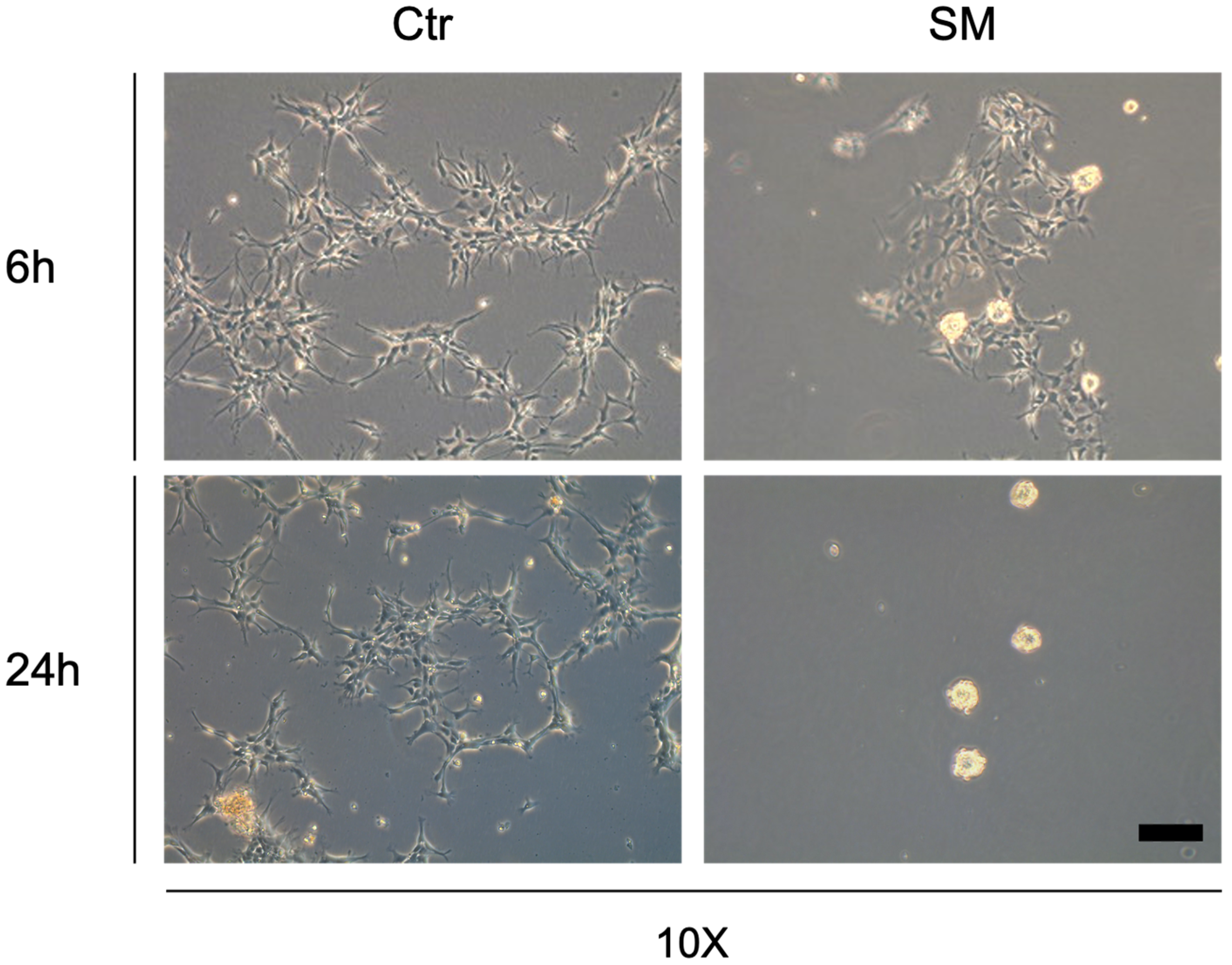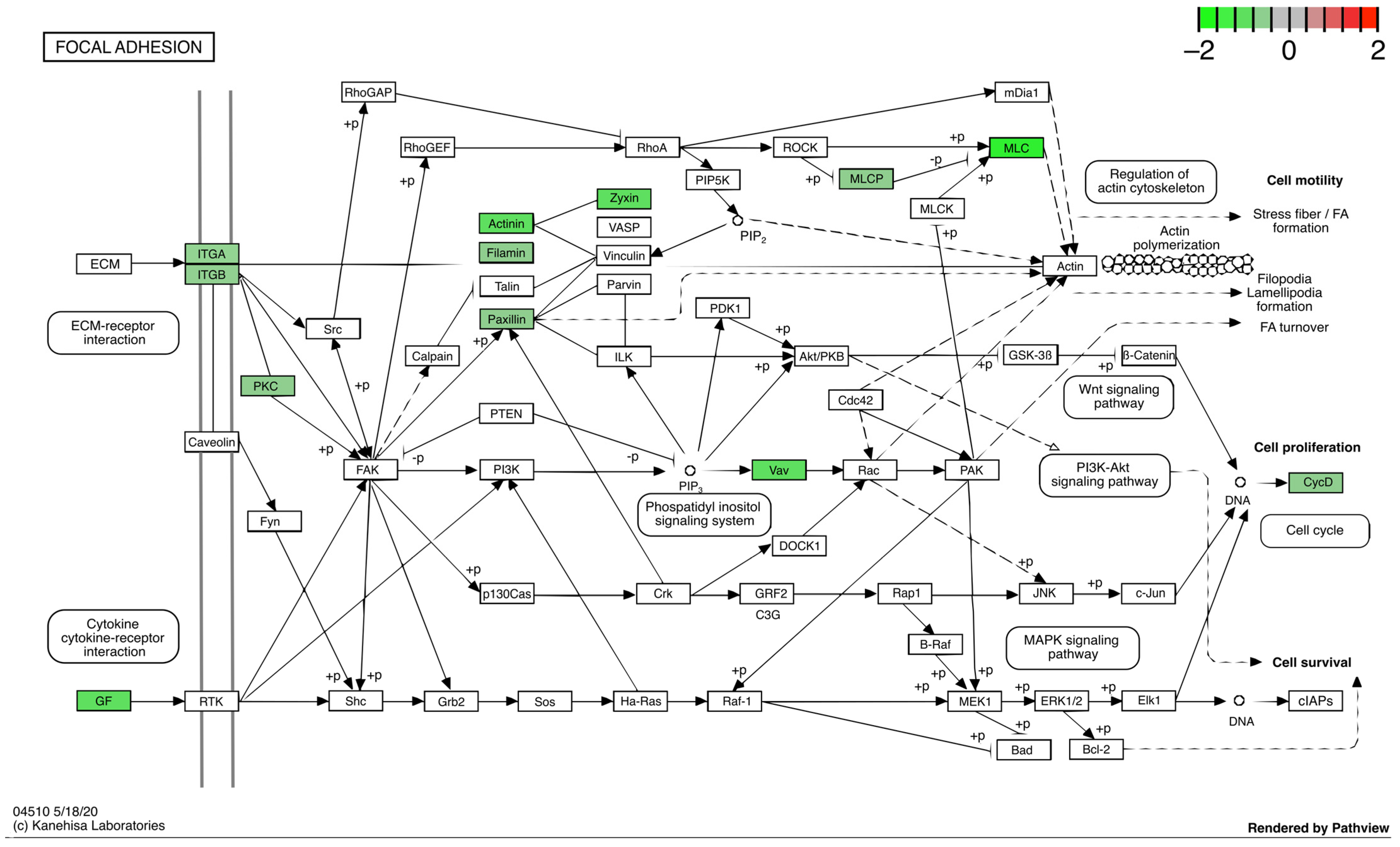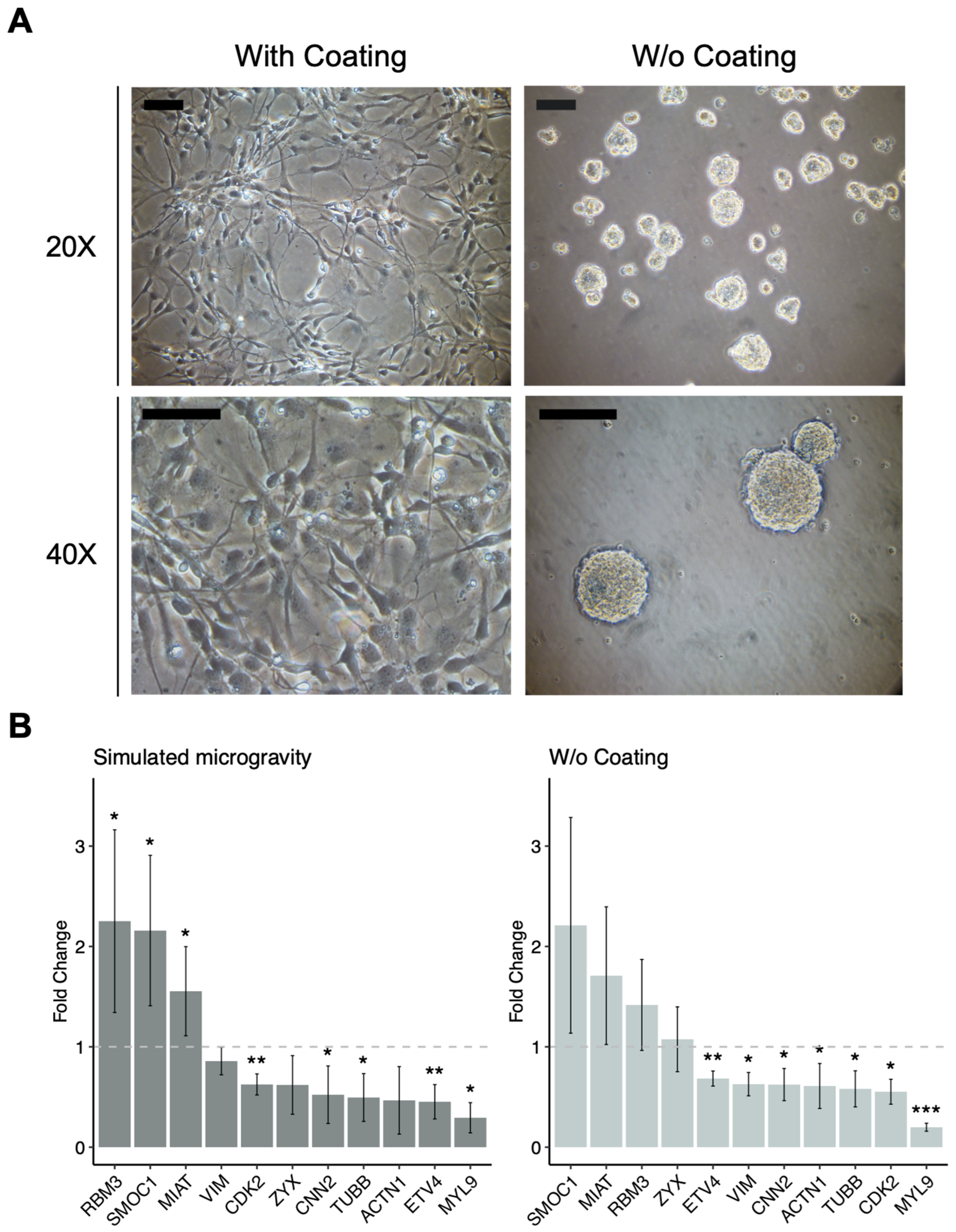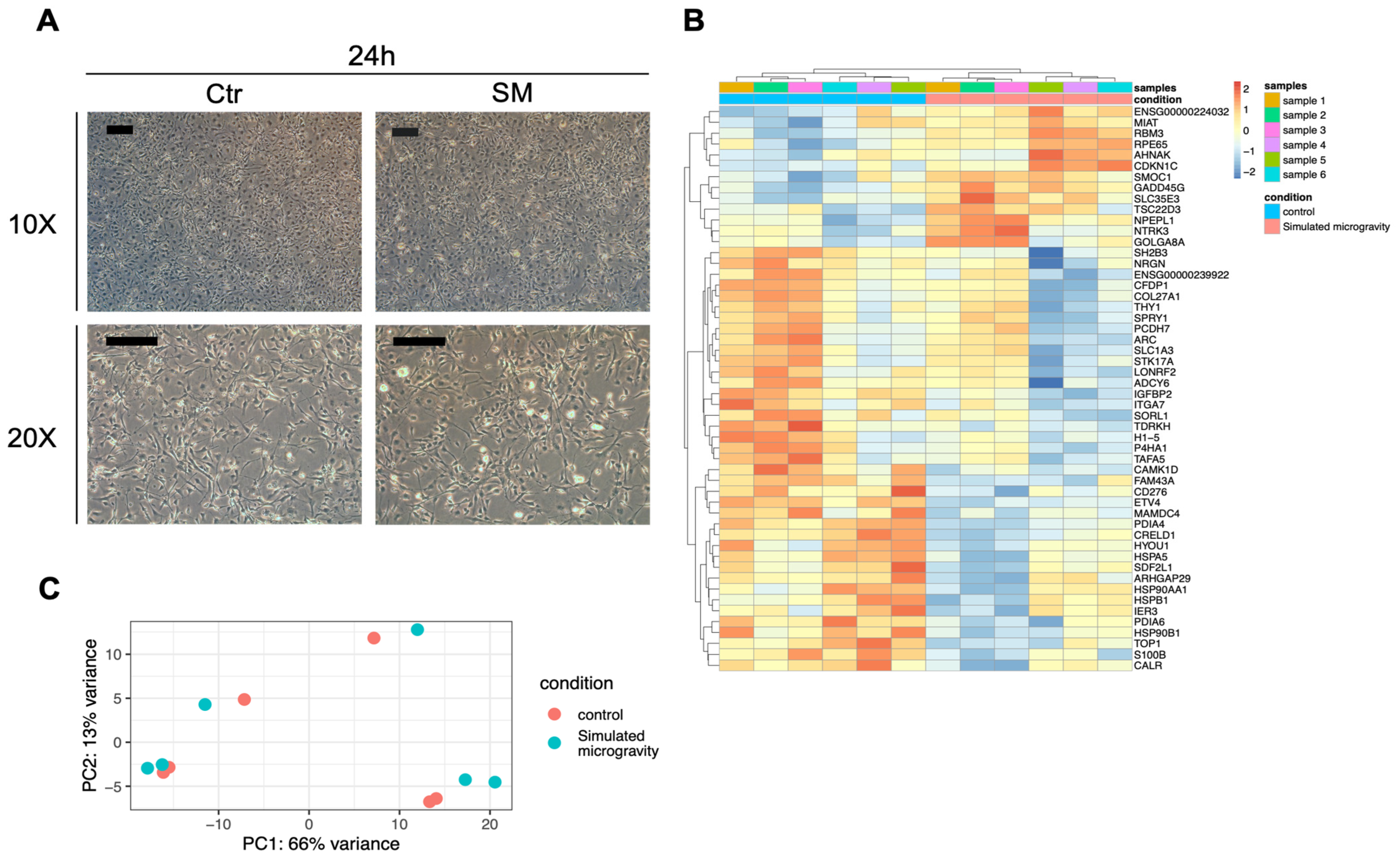Simulated Microgravity Modulates Focal Adhesion Gene Expression in Human Neural Stem Progenitor Cells
Abstract
1. Introduction
2. Materials and Methods
2.1. Cell Cultures and Exposure to Simulated Microgravity Conditions
2.2. RNA-Seq Analysis
2.3. Differential Gene Expression Analysis and Functional Enrichment Analysis
2.4. Real-Time Quantitative PCR
3. Results
3.1. Exposure to Simulated Microgravity Induces Morphological Changes in hNSPCs Grown at a Low Cell Density
3.2. Exposure to Simulated Microgravity induces Changes in the hNSPCs Transcriptome
3.3. HNSPCs Growth in Non-Adherent Conditions Partially Recapitulates the Transcriptomic Effects of Simulated Microgravity
3.4. Growth of hNSPCs at High Cell Density in Simulated Microgravity Conditions Causes Limited Morphological and Transcriptomic Changes
4. Discussion
5. Conclusions
Supplementary Materials
Author Contributions
Funding
Institutional Review Board Statement
Informed Consent Statement
Data Availability Statement
Acknowledgments
Conflicts of Interest
References
- Van Ombergen, A.; Demertzi, A.; Tomilovskaya, E.; Jeurissen, B.; Sijbers, J.; Kozlovskaya, I.B.; Parizel, P.M.; Van de Heyning, P.H.; Sunaert, S.; Laureys, S.; et al. The Effect of Spaceflight and Microgravity on the Human Brain. J. Neurol. 2017, 264, S18–S22. [Google Scholar] [CrossRef] [PubMed]
- Afshinnekoo, E.; Scott, R.T.; MacKay, M.J.; Pariset, E.; Cekanaviciute, E.; Barker, R.; Gilroy, S.; Hassane, D.; Smith, S.M.; Zwart, S.R.; et al. Fundamental Biological Features of Spaceflight: Advancing the Field to Enable Deep-Space Exploration. Cell 2020, 183, 1162–1184. [Google Scholar] [CrossRef] [PubMed]
- Grabherr, L.; Mast, F.W. Effects of Microgravity on Cognition: The Case of Mental Imagery. J. Vestib. Res.-Equilib. Orientat. 2010, 20, 53–60. [Google Scholar] [CrossRef] [PubMed]
- Williams, D.; Kuipers, A.; Mukai, C.; Thirsk, R. Acclimation during Space Flight: Effects on Human Physiology. Can. Med. Assoc. J. 2009, 180, 1317–1323. [Google Scholar] [CrossRef]
- Dai, S.; Mizuno, H.; Yumoto, A.; Shimomura, M.; Kobayashi, H.; Morita, H.; Shimbo, M.; Hamada, M.; Kudo, T.; Shinohara, M.; et al. Development of New Experimental Platform ’MARS’-Multiple Artificial-Gravity Research System-to Elucidate the Impacts of Micro/Partial Gravity on Mice. Sci. Rep. 2017, 7, 10837. [Google Scholar] [CrossRef]
- Naumenko, V.S.; Kulikov, A.V.; Kondaurova, E.M.; Tsybko, A.S.; Kulikova, E.A.; Krasnov, I.B.; Shenkman, B.S.; Sychev, V.N.; Bazhenova, E.Y.; Sinyakova, N.A.; et al. Effect of actual long-term spaceflight on bdnf, trkb, p75, bax and bcl-x-l genes expression in mouse brain regions. Neuroscience 2015, 284, 730–736. [Google Scholar] [CrossRef]
- Demertzi, A.; Van Ombergen, A.; Tomilovskaya, E.; Jeurissen, B.; Pechenkova, E.; Di Perri, C.; Litvinova, L.; Amico, E.; Rumshiskaya, A.; Rukavishnikov, I.; et al. Cortical Reorganization in an Astronaut’s Brain after Long-Duration Spaceflight. Brain Struct. Funct. 2016, 221, 2873–2876. [Google Scholar] [CrossRef]
- Hupfeld, K.E.; McGregor, H.R.; Reuter-Lorenz, P.A.; Seidler, R.D. Microgravity Effects on the Human Brain and Behavior: Dysfunction and Adaptive Plasticity. Neurosci. Biobehav. Rev. 2021, 122, 176–189. [Google Scholar] [CrossRef]
- DeFelipe, J.; Arellano, J.I.; Merchan-Perez, A.; Gonzalez-Albo, M.C.; Walton, K.; Llinas, R. Spaceflight Induces Changes in the Synaptic Circuitry of the Postnatal Developing Neocortex. Cereb. Cortex 2002, 12, 883–891. [Google Scholar] [CrossRef]
- Santucci, D.; Kawano, F.; Ohira, T.; Terada, M.; Nakai, N.; Francia, N.; Alleva, E.; Aloe, L.; Ochiai, T.; Cancedda, R.; et al. Evaluation of Gene, Protein and Neurotrophin Expression in the Brain of Mice Exposed to Space Environment for 91 Days. PLoS ONE 2012, 7, e40112. [Google Scholar] [CrossRef]
- Del Signore, A.; Mandillo, S.; Rizzo, A.; Di Mauro, E.; Mele, A.; Negri, R.; Oliverio, A.; Paggi, P. Hippocampal Gene Expression Is Modulated by Hypergravity. Eur. J. Neurosci 2004, 19, 667–677. [Google Scholar] [CrossRef] [PubMed]
- Ishikawa, C.; Li, H.; Ogura, R.; Yoshimura, Y.; Kudo, T.; Shirakawa, M.; Shiba, D.; Takahashi, S.; Morita, H.; Shiga, T. Effects of Gravity Changes on Gene Expression of BDNF and Serotonin Receptors in the Mouse Brain. PLoS ONE 2017, 12, e0177833. [Google Scholar] [CrossRef] [PubMed]
- Frigeri, A.; Iacobas, D.A.; Iacobas, S.; Nicchia, G.P.; Desaphy, J.F.; Camerino, D.C.; Svelto, M.; Spray, D.C. Effect of Microgravity on Gene Expression in Mouse Brain. Exp. Brain Res. 2008, 191, 289–300. [Google Scholar] [CrossRef] [PubMed]
- Chen, J.; Liu, R.; Yang, Y.; Li, J.; Zhang, X.; Li, J.; Wang, Z.; Ma, J. The Simulated Microgravity Enhances the Differentiation of Mesenchymal Stem Cells into Neurons. Neurosci. Lett. 2011, 505, 171–175. [Google Scholar] [CrossRef] [PubMed]
- Chiang, M.-C.; Lin, H.; Cheng, Y.-C.; Yen, C.-H.; Huang, R.-N.; Lin, K.-H. Beta-Adrenoceptor Pathway Enhances Mitochondrial Function in Human Neural Stem Cells via Rotary Cell Culture System. J. Neurosci. Methods 2012, 207, 130–136. [Google Scholar] [CrossRef]
- Dobin, A.; Davis, C.A.; Schlesinger, F.; Drenkow, J.; Zaleski, C.; Jha, S.; Batut, P.; Chaisson, M.; Gingeras, T.R. STAR: Ultrafast Universal RNA-Seq Aligner. Bioinformatics 2013, 29, 15–21. [Google Scholar] [CrossRef]
- Gentleman, R.C.; Carey, V.J.; Bates, D.M.; Bolstad, B.; Dettling, M.; Dudoit, S.; Ellis, B.; Gautier, L.; Ge, Y.; Gentry, J.; et al. Bioconductor: Open Software Development for Computational Biology and Bioinformatics. Genome Biol. 2004, 5, R80. [Google Scholar] [CrossRef]
- Huber, W.; Carey, V.J.; Gentleman, R.; Anders, S.; Carlson, M.; Carvalho, B.S.; Bravo, H.C.; Davis, S.; Gatto, L.; Girke, T.; et al. Orchestrating High-Throughput Genomic Analysis with Bioconductor. Nat. Methods 2015, 12, 115–121. [Google Scholar] [CrossRef]
- Wu, T.; Hu, E.; Xu, S.; Chen, M.; Guo, P.; Dai, Z.; Feng, T.; Zhou, L.; Tang, W.; Zhan, L.; et al. ClusterProfiler 4.0: A Universal Enrichment Tool for Interpreting Omics Data. Innovation 2021, 2, 100141. [Google Scholar] [CrossRef]
- Ogata, H.; Goto, S.; Sato, K.; Fujibuchi, W.; Bono, H.; Kanehisa, M. KEGG: Kyoto Encyclopedia of Genes and Genomes. Nucleic Acids Res. 1999, 27, 29–34. [Google Scholar] [CrossRef]
- Masiello, M.G.; Cucina, A.; Proietti, S.; Palombo, A.; Coluccia, P.; D’Anselmi, F.; Dinicola, S.; Pasqualato, A.; Morini, V.; Bizzarri, A. Phenotypic Switch Induced by Simulated Microgravity on MDA-MB-231 Breast Cancer Cells. Biomed Res. Int. 2014, 2014, 652434. [Google Scholar] [CrossRef] [PubMed]
- Kopp, S.; Slumstrup, L.; Corydon, T.J.; Sahana, J.; Aleshcheva, G.; Islam, T.; Magnusson, N.E.; Wehland, M.; Bauer, J.; Infanger, M.; et al. Identifications of Novel Mechanisms in Breast Cancer Cells Involving Duct-like Multicellular Spheroid Formation after Exposure to the Random Positioning Machine. Sci. Rep. 2016, 6, 26887. [Google Scholar] [CrossRef] [PubMed]
- Kopp, S.; Warnke, E.; Wehland, M.; Aleshcheva, G.; Magnusson, N.E.; Hemmersbach, R.; Corydon, T.J.; Bauer, J.; Infanger, M.; Grimm, D. Mechanisms of Three-Dimensional Growth of Thyroid Cells during Long-Term Simulated Microgravity. Sci. Rep. 2015, 5, 16691. [Google Scholar] [CrossRef] [PubMed]
- Grimm, D.; Wehland, M.; Pietsch, J.; Aleshcheva, G.; Wise, P.; van Loon, J.; Ulbrich, C.; Magnusson, N.E.; Infanger, M.; Bauer, J. Growing Tissues in Real and Simulated Microgravity: New Methods for Tissue Engineering. Tissue Eng. Part B-Rev. 2014, 20, 555–566. [Google Scholar] [CrossRef]
- Po, A.; Giuliani, A.; Masiello, M.G.; Cucina, A.; Catizone, A.; Ricci, G.; Chiacchiarini, M.; Tafani, M.; Ferretti, E.; Bizzarri, M. Phenotypic Transitions Enacted by Simulated Microgravity Do Not Alter Coherence in Gene Transcription Profile. npj Microgravity 2019, 5, 27. [Google Scholar] [CrossRef]
- Bizzarri, M.; Monici, M.; van Loon, J.J.W.A. How Microgravity Affects the Biology of Living Systems. Biomed Res. Int. 2015, 2015, 863075. [Google Scholar] [CrossRef]
- Redden, R.A.; Doolin, E.J. Microgravity Assay of Neuroblastoma: In Vitro Aggregation Kinetics and Organoid Morphology Correlate with MYCN Expression. Vitr. Cell. Dev. Biol.-Anim. 2011, 47, 312–317. [Google Scholar] [CrossRef]
- Harper, M.M.; Ye, E.-A.; Blong, C.C.; Jacobson, M.L.; Sakaguchi, D.S. Integrins Contribute to Initial Morphological Development and Process Outgrowth in Rat Adult Hippocampal Progenitor Cells. J. Mol. Neurosci. 2010, 40, 269–283. [Google Scholar] [CrossRef]
- Kechagia, J.Z.; Ivaska, J.; Roca-Cusachs, P. Integrins as Biomechanical Sensors of the Microenvironment. Nat. Rev. Mol. Cell Biol. 2019, 20, 457–473. [Google Scholar] [CrossRef]
- Gershovich, P.M.; Gershovich, J.G.; Zhambalova, A.P.; Romanov, Y.A.; Buravkova, L.B. Cytoskeletal Proteins and Stem Cell Markers Gene Expression in Human Bone Marrow Mesenchymal Stromal Cells after Different Periods of Simulated Microgravity. Acta Astronaut. 2012, 70, 36–42. [Google Scholar] [CrossRef]
- Leguy, C.A.D.; Delfos, R.; Pourquie, M.J.B.M.; Poelma, C.; Westerweel, J.; van Loon, J.J.W.A. Fluid Dynamics during Random Positioning Machine Micro-Gravity Experiments. Adv. Space Res. 2017, 59, 3045–3057. [Google Scholar] [CrossRef]
- van Loon, J.J.W.A. Some History and Use of the Random Positioning Machine, RPM, in Gravity Related Research. Adv. Space Res. 2007, 39, 1161–1165. [Google Scholar] [CrossRef]
- Avila-Mendoza, J.; Subramani, A.; Sifuentes, C.J.; Denver, R.J. Molecular Mechanisms for Kruppel-Like Factor 13 Actions in Hippocampal Neurons. Mol. Neurobiol. 2020, 57, 3785–3802. [Google Scholar] [CrossRef] [PubMed]
- Yang, C.; Zhang, Y.; Yang, B. MIAT, a Potent CVD-Promoting LncRNA. Cell. Mol. Life Sci. 2022, 79, 43. [Google Scholar] [CrossRef]
- Li, T.; Xu, L.; Teng, J.; Ma, Y.; Liu, W.; Wang, Y.; Chi, X.; Shao, S.; Dong, Y.; Zhan, Q.; et al. GADD45G Interacts with E-Cadherin to Suppress the Migration and Invasion of Esophageal Squamous Cell Carcinoma. Dig. Dis. Sci. 2020, 65, 1032–1041. [Google Scholar] [CrossRef]
- Vahlensieck, C.; Thiel, C.S.; Zhang, Y.; Huge, A.; Ullrich, O. Gravitational Force-Induced 3D Chromosomal Conformational Changes Are Associated with Rapid Transcriptional Response in Human T Cells. Int. J. Mol. Sci. 2021, 22, 9426. [Google Scholar] [CrossRef]
- Vahlensieck, C.; Thiel, C.S.; Pöschl, D.; Bradley, T.; Krammer, S.; Lauber, B.; Polzer, J.; Ullrich, O. Post-Transcriptional Dynamics Is Involved in Rapid Adaptation to Hypergravity in Jurkat T Cells. Front. Cell Dev. Biol. 2022, 10, 933984. [Google Scholar] [CrossRef]
- Häder, D.-P.; Braun, M.; Grimm, D.; Hemmersbach, R. Gravireceptors in Eukaryotes—A Comparison of Case Studies on the Cellular Level. npj Microgravity 2017, 3, 13. [Google Scholar] [CrossRef]
- Vorselen, D.; Roos, W.H.; MacKintosh, F.C.; Wuite, G.J.L.; van Loon, J.J.W.A. The Role of the Cytoskeleton in Sensing Changes in Gravity by Nonspecialized Cells. FASEB J. 2014, 28, 536–547. [Google Scholar] [CrossRef]






| Condition | Experiment | Time | Cell/cm2 | Neurospheres | Vitality |
|---|---|---|---|---|---|
| Ctr | 1 | 6 h | 22,000 | No | 59% |
| Ctr | 1 | 24 h | 20,800 | No | 56% |
| SM | 1 | 6 h | 16,000 | <10% | 62% |
| SM | 1 | 24 h | 11,105 | >60% | 55% |
| Ctr | 2 | 6 h | 19,260 | No | 92% |
| Ctr | 2 | 24 h | 33,360 | No | 85% |
| SM | 2 | 6 h | 13,192 | <10% | 92% |
| SM | 2 | 24 h | 19,850 | >60% | 85% |
| Ctr | 3 | 6 h | 26,315 | No | 84% |
| Ctr | 3 | 24 h | 41,650 | No | 92% |
| SM | 3 | 6 h | 22,080 | <10% | 89% |
| SM | 3 | 24 h | 25,775 | >60% | 88% |
| Ctr | 4 | 24 h | 41,900 | No | NA |
| SM | 4 | 24 h | 46,966 | <5% | NA |
| Ctr | 5 | 24 h | 33,533 | No | NA |
| SM | 5 | 24 h | 38,266 | <5% | NA |
| Ctr | 6 | 24 h | 86,333 | No | 92% |
| SM | 6 | 24 h | 82,333 | No | 90% |
Publisher’s Note: MDPI stays neutral with regard to jurisdictional claims in published maps and institutional affiliations. |
© 2022 by the authors. Licensee MDPI, Basel, Switzerland. This article is an open access article distributed under the terms and conditions of the Creative Commons Attribution (CC BY) license (https://creativecommons.org/licenses/by/4.0/).
Share and Cite
Wang, W.; Di Nisio, E.; Licursi, V.; Cacci, E.; Lupo, G.; Kokaia, Z.; Galanti, S.; Degan, P.; D’Angelo, S.; Castagnola, P.; et al. Simulated Microgravity Modulates Focal Adhesion Gene Expression in Human Neural Stem Progenitor Cells. Life 2022, 12, 1827. https://doi.org/10.3390/life12111827
Wang W, Di Nisio E, Licursi V, Cacci E, Lupo G, Kokaia Z, Galanti S, Degan P, D’Angelo S, Castagnola P, et al. Simulated Microgravity Modulates Focal Adhesion Gene Expression in Human Neural Stem Progenitor Cells. Life. 2022; 12(11):1827. https://doi.org/10.3390/life12111827
Chicago/Turabian StyleWang, Wei, Elena Di Nisio, Valerio Licursi, Emanuele Cacci, Giuseppe Lupo, Zaal Kokaia, Sergio Galanti, Paolo Degan, Sara D’Angelo, Patrizio Castagnola, and et al. 2022. "Simulated Microgravity Modulates Focal Adhesion Gene Expression in Human Neural Stem Progenitor Cells" Life 12, no. 11: 1827. https://doi.org/10.3390/life12111827
APA StyleWang, W., Di Nisio, E., Licursi, V., Cacci, E., Lupo, G., Kokaia, Z., Galanti, S., Degan, P., D’Angelo, S., Castagnola, P., Tavella, S., & Negri, R. (2022). Simulated Microgravity Modulates Focal Adhesion Gene Expression in Human Neural Stem Progenitor Cells. Life, 12(11), 1827. https://doi.org/10.3390/life12111827










